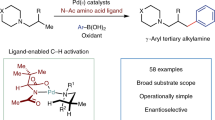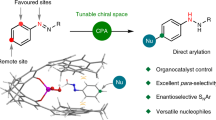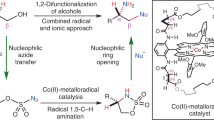Abstract
Site-selective C−H functionalization has emerged as an attractive tool for derivatizing complex synthetic intermediates, but its use for late-stage diversification is limited by the functional groups that can be introduced, especially at unactivated sp3-hybridized positions. To overcome this, we introduce a strategy that directly installs a sulfonyloxy group at a β-C−H bond of a masked alcohol and subsequently employs nucleophilic substitution reactions to prepare various derivatives. Hydroxyl groups are widely found in bioactive molecules and are thus readily available as synthetic handles. A directing group is easily added (and subsequently removed) from the alcohols such that a formal site-selective β-C−H sulfonyloxylation of these alcohols is achieved. Substitution reactions with carbon, nitrogen, oxygen and other nucleophiles then lead to diverse functionalizations that may help to streamline the synthesis of complex analogues for drug discovery.
This is a preview of subscription content, access via your institution
Access options
Subscribe to this journal
Receive 12 print issues and online access
$259.00 per year
only $21.58 per issue
Buy this article
- Purchase on Springer Link
- Instant access to full article PDF
Prices may be subject to local taxes which are calculated during checkout



Similar content being viewed by others
Change history
09 September 2015
In the original graphical abstract for this Article, an in-house error meant that the product structures were incorrect. This has now been corrected in all versions of the article.
References
Thompson, L. A. & Ellman, J. A. Synthesis and applications of small molecule libraries. Chem. Rev. 96, 555–600 (1996).
Bryan, M. C. et al. Sustainable practices in medicinal chemistry: current state and future directions. J. Med. Chem. 56, 6007–6021 (2013).
Nicolaou, K. C. The chemistry–biology–medicine continuum and the drug discovery and development process in academia. Chem. Biol. 21, 1039–1045 (2014).
Wencel-Delord, J. & Glorius, F. C–H bond activation enables the rapid construction and late-stage diversification of functional molecules. Nature Chem. 5, 369–375 (2013).
Dai, H.-X., Stepan, A. F., Plummer, M. S., Zhang, Y.-H. & Yu, J.-Q. Divergent C–H functionalizations directed by sulfonamide pharmacophores: late-stage diversification as a tool for drug discovery. J. Am. Chem. Soc. 133, 7222–7228 (2011).
Rosen, B. R. et al. C–H functionalization logic enables synthesis of (+)-hongoquercin A and related compounds. Angew. Chem. Int. Ed. 52, 7317–7320 (2013).
He, G. & Chen, G. A practical strategy for the structural diversification of aliphatic scaffolds through the palladium-catalyzed picolinamide-directed remote functionalization of unactivated C(sp3)–H bonds. Angew. Chem. Int. Ed. 50, 5192–5196 (2011).
Newhouse, T. & Baran, P. S. If C–H bonds could talk: selective C–H bond oxidation. Angew. Chem. Int. Ed. 50, 3362–3374 (2011).
Davies, H. M. L. & Manning, J. R. Catalytic C–H functionalization by metal carbenoid and nitrenoid insertion. Nature 451, 417–424 (2008).
Daugulis, O., Do, H.-Q. & Shabashov, D. Palladium- and copper-catalyzed arylation of carbon–hydrogen bonds. Acc. Chem. Res. 42, 1074–1086 (2009).
Davies, H. M. L., Du Bois, J. & Yu, J.-Q. C−H functionalization in organic synthesis. Chem. Soc. Rev. 40, 1855–1856 (2011).
Lyons, T. W. & Sanford, M. S. Palladium-catalyzed ligand-directed C–H functionalization reactions. Chem. Rev. 110, 1147–1169 (2010).
Colby, D. A., Bergman, R. G. & Ellman, J. A. Rhodium-catalyzed C–C bond formation via heteroatom-directed C–H bond activation. Chem. Rev. 110, 624–655 (2010).
Yu, J.-Q. & Shi, Z.-J. C–H Activation (Topics in Current Chemistry 292, Springer, 2010).
Yamaguchi, J., Yamaguchi, A. D. & Itami, K. C–H bond functionalization: emerging synthetic tools for natural products and pharmaceuticals. Angew. Chem. Int. Ed. 51, 8960–9009 (2012).
White, M. C. Adding aliphatic C–H bond oxidations to synthesis. Science 335, 807–809 (2012).
Li, H., Li, B.-J. & Shi, Z.-J. Challenge and progress: palladium-catalyzed sp3 C–H activation. Catal. Sci. Technol. 1, 191–206 (2011).
Hartwig, J. F. Borylation and silylation of C–H bonds: a platform for diverse C–H bond functionalizations. Acc. Chem. Res. 45, 864–873 (2012).
Robbins, D. W. & Hartwig, J. F. Sterically controlled alkylation of arenes through iridium-catalyzed C–H borylation. Angew. Chem. Int. Ed. 52, 933–937 (2013).
Larsen, M. A. & Hartwig, J. F. Iridium-catalyzed C−H borylation of heteroarenes: scope, regioselectivity, application to late-stage functionalization, and mechanism. J. Am. Chem. Soc. 136, 4287–4299 (2014).
Cho, J.-Y., Tse, M. K., Holmes, D., Maleczka, R. E. & Smith, M. R. Remarkably selective iridium catalysts for the elaboration of aromatic C−H bonds. Science 295, 305–308 (2002).
Ishiyama, T. et al. Mild iridium-catalyzed borylation of arenes. High turnover numbers, room temperature reactions, and isolation of a potential intermediate. J. Am. Chem. Soc. 124, 390–391 (2002).
Ishiyama, T., Sato, K., Nishio, Y. & Miyaura, N. Direct synthesis of aryl halosilanes through iridium(I)-catalyzed aromatic C–H silylation by disilanes. Angew. Chem. Int. Ed. 42, 5346–5348 (2003).
Cheng, C. & Hartwig, J. F. Rhodium-catalyzed intermolecular C–H silylation of arenes with high steric regiocontrol. Science 343, 853–857 (2014). .
Fier, P. S. & Hartwig, J. F. Selective C–H fluorination of pyridines and diazines inspired by a classic amination reaction. Science 342, 956–960 (2013).
Mkhalid, I. A. I., Barnard, J. H., Marder, T. B., Murphy, J. M. & Hartwig, J. F. C–H activation for the construction of C–B bonds. Chem. Rev. 110, 890–931 (2010).
Liskey, C. W. & Hartwig, J. F. Iridium-catalyzed borylation of secondary C–H bonds in cyclic ethers. J. Am. Chem. Soc. 134, 12422–12425 (2012).
Li, Q., Liskey, C. W. & Hartwig, J. F. Regioselective borylation of the C–H bonds in alkylamines and alkyl ethers. Observation and origin of high reactivity of primary C–H bonds beta to nitrogen and oxygen. J. Am. Chem. Soc. 136, 8755–8765 (2014).
Simmons, E. M. & Hartwig, J. F. Catalytic functionalization of unactivated primary C–H bonds directed by an alcohol. Nature 483, 70–73 (2012).
Kawamorita, S., Murakami, R., Iwai, T. & Sawamura, M. Synthesis of primary and secondary alkylboronates through site-selective C(sp3)–H activation with silica-supported monophosphine–Ir catalysts. J. Am. Chem. Soc. 135, 2947–2950 (2013).
Zhang, L.-S. et al. Direct borylation of primary C–H bonds in functionalized molecules by palladium catalysis. Angew. Chem. Int. Ed. 53, 3899–3903 (2014).
Jana, R., Pathak, T. P. & Sigman, M. S. Advances in transition metal (Pd, Ni, Fe)-catalyzed cross-coupling reactions using alkyl-organometallics as reaction partners. Chem. Rev. 111, 1417–1492 (2011).
Smith, M. B. & March, J. March’s Advanced Organic Chemistry (Wiley, 2001).
Liu, W. & Groves, J. T. Manganese porphyrins catalyze selective C–H bond halogenations. J. Am. Chem. Soc. 132, 12847–12849 (2010).
Schmidt, V. A., Quinn, R. K., Brusoe, A. T. & Alexanian, E. J. Site-selective aliphatic C–H bromination using N-bromoamides and visible light. J. Am. Chem. Soc. 136, 14389–14392 (2014).
Giri, R., Chen, X. & Yu, J.-Q. Palladium-catalyzed asymmetric iodination of unactivated C–H bonds under mild conditions. Angew. Chem. Int. Ed. 44, 2112–2115 (2005).
Giri, R. et al. Catalytic and stereoselective iodination of prochiral C–H bonds. Tetrahedron: Asymmetry 16, 3502–3505 (2005).
Wasa, M. & Yu, J.-Q. Synthesis of β-, γ-, and δ-lactams via Pd(II)-catalyzed C–H activation reactions. J. Am. Chem. Soc. 130, 14058–14059 (2008).
Rit, R. K., Yadav, M. R., Ghosh, K., Shankar, M. & Sahoo, A. K. Sulfoximine assisted Pd(II)-catalyzed bromination and chlorination of primary β-C(sp3)–H bond. Org. Lett. 16, 5258–5261 (2014).
Mo, F. & Dong, G. Alcohols or masked alcohols as directing groups for C–H bond functionalization. Chem. Lett. 43, 264–271 (2014).
Camasso, N. M., Pérez-Temprano, M. H. & Sanford, M. S. C(sp3)–O bond-forming reductive elimination from PdIV with diverse oxygen nucleophiles. J. Am. Chem. Soc. 136, 12771–12775 (2014).
Powers, D. C. et al. Connecting binuclear Pd(III) and mononuclear Pd(IV) chemistry by Pd–Pd bond cleavage. J. Am. Chem. Soc. 134, 12002–12009 (2012).
Ren, Z., Mo, F. & Dong, G. Catalytic functionalization of unactivated sp3 C–H bonds via exo-directing groups: synthesis of chemically differentiated 1,2-diols. J. Am. Chem. Soc. 134, 16991–16994 (2012).
Desai, L. V., Hull, K. L. & Sanford, M. S. Palladium-catalyzed oxygenation of unactivated sp3 C–H bonds. J. Am. Chem. Soc. 126, 9542–9543 (2004).
Choong, I. C. & Ellman, J. A. Synthesis of alkoxylamines by alkoxide amination with 3,3′-di-tert-butyloxaziridine. J. Org. Chem. 64, 6528–6529 (1999).
Acknowledgements
We thank the Cancer Prevention Research Institute of Texas for a start-up fund (R1118), the Welch Foundation (F-1781), Frasch Foundation and an American Chemical Society Petroleum Research Fund for research grants. G.D. is a Searle Scholar. V. Lynch is acknowledged for X-ray crystallography. We thank W. Pan for preparing substrates and M. Young for proofreading the manuscript. We also thank Johnson Matthey for a generous donation of palladium salts.
Author information
Authors and Affiliations
Contributions
Y.X. and G.Y. contributed equally to this work. Y.X., G.Y. and G.D. conceived and designed the experiments. Y.X., G.Y. and Z.R. performed the experiments. Y.X., G.Y. and Z.R. analysed the data. Y.X. and G.D. co-wrote the manuscript.
Corresponding author
Ethics declarations
Competing interests
The authors declare no competing financial interests.
Supplementary information
Supplementary information
Supplementary information (PDF 15884 kb)
Supplementary information
Crystallographic data for compound 3c. (CIF 437 kb)
Supplementary information
Crystallographic data for compound 6. (CIF 2020 kb)
Rights and permissions
About this article
Cite this article
Xu, Y., Yan, G., Ren, Z. et al. Diverse sp3 C−H functionalization through alcohol β-sulfonyloxylation. Nature Chem 7, 829–834 (2015). https://doi.org/10.1038/nchem.2326
Received:
Accepted:
Published:
Issue Date:
DOI: https://doi.org/10.1038/nchem.2326
This article is cited by
-
Site-selective C-H hydroxylation of pentacyclic triterpenoids directed by transient chiral pyridine-imino groups
Nature Communications (2020)
-
Reversing conventional site-selectivity in C(sp3)–H bond activation
Nature Chemistry (2019)



